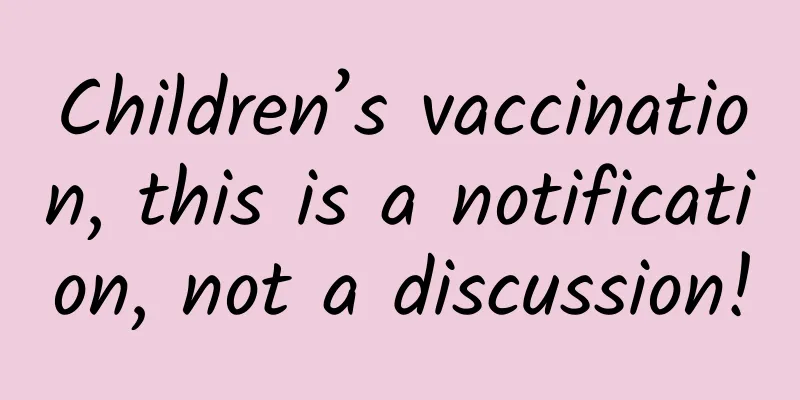Children’s vaccination, this is a notification, not a discussion!

|
In 1986, the State Council established April 25 of each year as the "National Children's Vaccination Day" in my country, with the aim of popularizing immunization and allowing every parent to understand and deeply appreciate that "immunization is a right that every child should enjoy", thereby increasing vaccination rates and protecting children's health. After more than 30 years of hard work by vaccine workers, my country has established a comprehensive immunization program: within 24 hours of birth, hepatitis B vaccine and BCG vaccine are administered, and between 1 month and 18 months of age, most vaccines in the program are injected, including inactivated polio vaccine, diphtheria, pertussis, measles, mumps and rubella vaccine, inactivated Japanese encephalitis vaccine, group A meningococcal polysaccharide vaccine, and live attenuated hepatitis A vaccine (see Figure 1[1]). Vaccines are the world's safest way to protect children from deadly diseases. According to the World Health Organization, the current childhood immunization program saves the lives of 2-3 million children worldwide each year. The proportion of children under 5 years old who died from communicable diseases dropped from 9.3% in 1990 to 3.9% in 2018[2]. Let's look at the specific performance of several vaccines in my country: through oral polio sugar pills, my country has blocked the spread of local polio virus since 1995, preventing tens of thousands of children from limb disability; after the popularization of hepatitis B vaccination for newborns, the hepatitis B virus carrier rate of children under 5 years old in my country has dropped from 9.7% in 1992 to 0.3% in 2014; in the middle of the last century, the annual number of measles cases in my country was as high as more than 9 million, and by 2020, the number of cases was less than 1,000, and the incidence rate dropped to 0.06, 100,000; before the popularization of child immunization, diphtheria could cause hundreds of thousands of children to become ill each year, and after 2006, there have been no diphtheria cases reported in my country. In the 1960s, the highest year for the incidence of meningococcal meningitis in my country was as high as 3.04 million cases, and by 2020, the number of cases has been less than 200; the highest year for Japanese encephalitis was nearly 200,000 cases, and the number of cases in 2017 was only more than 1,000; the national neonatal tetanus incidence rate has remained below 1‰. In 2012, the World Health Organization certified that my country has achieved the goal of eliminating neonatal tetanus. (Data from China Centers for Disease Control and Prevention) Childhood vaccination promotion is a global task, and countries around the world have started "fancy" vaccination promotion since the World Health Organization proposed the Expanded Immunization Program in 1974. For example, in the United States, immunization records are required for school enrollment and work, and the American Academy of Pediatrics regards parents' refusal to vaccinate their children as medical negligence and reports it to the National Child Protection Service. In 2012, the World Health Organization and UNICEF jointly proposed the Global Vaccine Action Plan, which is committed to ensuring that the poorest and most marginalized children have access to vaccines and to increasing global child vaccination rates, in the hope of truly eliminating the threat of pathogenic bacteria to children around the world. The principle of vaccines is simple, but there are many difficulties in the research and development process, and vaccines developed for newborns or infants must be developed with even more caution. The immune systems of newborns and children are far less mature than those of adults. Most immune cells are undifferentiated and do not have special functions. They need longer reaction time to see bacteria or viruses. Some organs involved in immunity have not yet developed well. Therefore, many adult or animal experimental data of vaccines have no reference value for the development of children's vaccines. Primary cells collected from newborns are needed to verify the effect of vaccines to see whether the neonatal macrophages, antigen-presenting cells, and lymphocytes function normally under the stimulation of vaccines. Next, according to the results of in vitro experiments, appropriate animal models are selected to verify whether the vaccine can provide protection against viruses or bacteria in animals such as newborn mice. After the effectiveness and safety are confirmed in animal models, clinical phases I to III experiments will be carried out. From the time the first childhood vaccine, pertussis vaccine, was approved for use in the United States in 1914 to the present day, childhood vaccines have gone through more than a century of development, including three stages. The first phase of vaccines (1890–1950) mainly targeted bacteria. Scientists at the time were working hard to isolate and purify live pathogens, inactivate pathogens and preserve the complete bacterial structure, and reduce bacterial virulence. From 1950 to 1970, with the improvement of virus purification and culture technology, the development of viral vaccines was booming, including rabies virus vaccine, influenza vaccine, etc. By 1980, the successful development of combined vaccines was also a prominent progress in the development of children's vaccines, which reduced a lot of trouble for children and parents. Take DPT as an example. If the diphtheria, pertussis and tetanus vaccines included in it are given separately, the child needs to receive 12 shots of the vaccine, but only 4 shots are needed to solve the problem, which greatly reduces the pain of vaccination for children and the potential adverse risks. Improving the popularity of vaccines and developing new vaccines must go hand in hand to continuously reduce the mortality rate of neonatal infections. Recently launched children's pneumococcal vaccines, Haemophilus influenzae type b vaccines (Hib vaccines), rotavirus, varicella vaccines, enterovirus EV71 vaccines, etc., also provide more extensive protection for newborns or children. The latest pentavalent vaccine includes pertussis, diphtheria, tetanus, polio, and Hib vaccines are also a good choice. Although the childhood vaccine program has greatly reduced the mortality rate of newborns infected with deadly infectious diseases, some cunning pathogens are still at large, especially HIV, hepatitis C virus, Ebola, tuberculosis and other infectious sources with high mortality rates, for which there are still no corresponding effective vaccines. HIV and hepatitis C viruses are more prone to mutation, and it is difficult to find conserved protein sites that can trigger antibody responses. Once the virus mutates and the immune system cannot recognize it, the vaccine developed with great difficulty will fail. Tuberculosis, an ancient bacterium, can always easily escape the immune system, which is also a major difficulty in vaccine development. The BCG vaccine we received as children is only effective for 10-15 years. How to extend the protection of tuberculosis vaccine, preferably for life, is also a problem that scientists need to solve urgently. In general, my country's child vaccination and promotion work has been progressing steadily, with the vaccine coverage rate exceeding 90% for consecutive years. Maintaining a high level of vaccination rate is the responsibility of the whole society. Whether as a parent or a vaccine service worker, ensuring that every child is vaccinated on time is the best gift for his healthy growth. References National Immunization Program Vaccine Childhood Immunization Schedule and Instructions (2021 Edition) This article is a work supported by Science Popularization China Starry Sky Project Author: Zhao Bei Reviewer: Qiao Jiange, Head Nurse and Deputy Chief Nurse, Geriatric Ward, Shanghai Fifth People's Hospital Produced by: China Association for Science and Technology Department of Science Popularization Producer: China Science and Technology Press Co., Ltd., Beijing Zhongke Xinghe Culture Media Co., Ltd. |
<<: Spring is a good time to take care of your liver, but don’t do these 4 things!
>>: Vaccination is the best way to prevent rotavirus infection in infants and young children
Recommend
Girls often run face sagging
Girls who run regularly will not have sagging fac...
Causes of gynecological inflammation
Gynecological inflammation has caused a lot of ha...
What are the benefits of sweating during the full moon?
The main benefit of sweating during the full moon...
Gynecological suppositories complete pictures
Girls should pay attention to proper physical hea...
Chinese medicine prescription for regulating menstruation and replenishing qi and blood
Most female friends have irregular menstruation a...
Girls' sinus rhythm with left axis deviation
Nowadays, both the company physical examination a...
About hard lumps on the vulva
The lumps on the vulva can be big or small, which...
What is the reason for the continuous recurrence of vulvar leukoplakia?
Vulvar leukoplakia is a gynecological disease tha...
What does breast nodule grade 4b mean?
Breast lumps are generally a disease caused by ch...
Which skin care products should not be mixed?
Many women use a whole set of skin care products ...
How to maintain the uterus?
The uterus is an important physiological feature ...
What causes painful urination?
I believe many people will wonder what kind of di...
Which groups of people are at high risk of developing cancer?
But in fact, the number of people suffering from ...
What should breastfeeding mothers eat to replenish qi and blood
As we all know, women need to breastfeed after gi...
"Seventh to eight but not alive"? Premature babies are more likely to have these dangerous conditions, and care should pay attention to 4 points
gossip November 17 (tomorrow) is World Prematurit...









